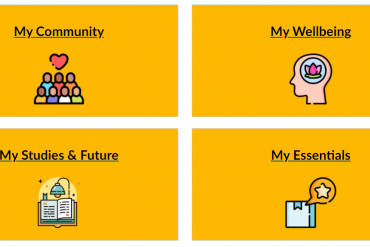Transition is key to developing a sense of belonging which is itself strongly associated with retention, student satisfaction and achievement. At Sydney, even in the ‘Time Before the Pandemic’, there was a strong correlation between sense of belonging, the overall student experience and grades. In the 2020, as the first wave of lockdowns forced remote learning and teaching, students reported (as described by The Guardian and The Australian) strongly decreased satisfaction with learner engagement and their sense of belonging at all Australian universities. Sydney was no exception, dropping 10 percentage points in student satisfaction. The students beginning their studies next year have had an even more challenging 2021 with those presently at school having had hugely disrupted studies and ongoing worries and uncertainties about assessment and those returning to study dealing with cancelled travel and the stresses of an extended lockdown.
Transition pedagogy
Kift’s First Year Curriculum Principles (Kift, 20091; Kift 20152) reflect extensive research on what leads students to transition successfully to university and sets them up with the skills and study habits to become independent learners through their lives: (i) transition, (ii) diversity, (iii) design, (iv) engagement, (v) assessment and (vi) evaluation and monitoring. As Kift (2009) states embedding these in the curriculum is crucial:
The curriculum and its delivery should be designed to be consistent and explicit in assisting students’ transition from their previous educational experience to the nature of learning in higher education and learning in their discipline as part of their lifelong learning. The first year curriculum should be designed to mediate and support transition as a process that occurs over time.
Given the previous educational experience of our new and returning students has occurred amidst health scares, lockdowns and interrupted schooling, it is useful to provide a set of considerations and research-based activities for educators to adapt to their own situations.
Student success after lockdown
An excellent recent paper by Pownall, Harris and Blundell-Birtill3 describes key evidence-based and psychology-informed considerations for UK educators as students return to study after hugely disrupted preparations and examinations. There are many parallels with where Sydney is likely to be at the start of the new academic year in 2022. In this article, we describe these considerations and how they can be addressed through an intentionally designed transition pedagogy embedded in the curriculum.
Since March 2020, school has been regularly interrupted by lockdowns and Covid-19 breakouts, with students in Sydney homeschooling from early July with, at the time of writing, a full return planned at the end of October. With the timing and nature of HSC examinations still to be fully decided and all plans built on modelling and subject to rapid change, it is clear that our new students will arrive having missed a considerable amount of their schooling as well as more hidden social and academic skill development. The nature of the schooling and support and the quality of the online education they have received is also likely to have exacerbated existing inequities (Bayrakdar & Guveli, 2020; Moreno & Gortazar, 2020; Myers, 2021). Research in Australia (Armour et al., 2020) suggests that prolonged remote learning has the potential to result in poorer educational outcomes for almost half of Australian school students (Brown et al., 2020; Drane et al., 2020). Students are also facing mental health challenges (Irawan et al., 2020; Van Lancker & Parolin, 2020; Thakur, 2020). The Sydney Morning Herald has reported low motivation levels in HSC students, with 90% reporting effects on their mental health due to uncertainties around their examinations.
Pownall, Harris and Blundell-Birtill align their recommendations with the ‘Five Senses of Student Success’ model (Chester et al., 2013; Lizzio, 2006) which relates student success to their capability, connectedness, purpose, resourcefulness and culture. Although we discuss further alignment of these recommendations to a transition pedagogy embedded in the first-year curriculum, it is clear that they are also relevant to students returning to study at all levels in 2022 with the words we wrote in 2020 about the importance of developing a sense of purpose in our second year students even more pertinent now.
1. Capability: reacclimatising to studying
The effect of homeschooling on students’ academic knowledge is difficult to predict. As noted above, it is likely to be very uneven across the diversity of our student cohort. Students are likely to be less equipped for study and will have different approaches after 2 years of uncertainty and switching between face-to-face and prolonged remote teaching. The challenge for educators is how to account for this in the curriculum and in assessment. The need to adjust learning outcomes and expectations of standards may already be evident in 2021 with evidence emerging of poorer results for those students who entered following the disruptions of 2020.
Having clear communications and expectations will be crucial throughout the curriculum. Diagnostic and formative assessment that provides feedback to both students and educators will be needed to ensure ‘in-flight’ alignment of expectations and capabilities. A reduced emphasis on large summative examinations in favour of meaningful assessment will promote self-efficacy (Lizzio and Wilson, 2008), rather than anxiety, and clarify its primary purpose in first year as part of the learning process. There is strong evidence for best practice in how assessment design can facilitate successful transition. In many units, online assessments, such as MCQs, have been built in 2020 and 2021. What better time to re-use these as low-stakes formative assessments to help students gain confidence (Boitshwarelo et al. 2017) and to provide ways to measure and support engagement?
There is overwhelmingly strong evidence that active learning and teaching approaches drastically improve student outcomes and significantly reduce achievement gaps for less-prepared students. Students should be given every opportunity to actively engage in their studies and transition (Crafter and Maunder, 2017) by aligning teaching approaches to the ‘Principles Guiding Education at Sydney‘. For example, to ensure students’ academic skills and understanding are aligned with our expectations of academic integrity, we can partner with students using facilitated discussions on why integrity is a core value and why we reference.
2. Connectedness: imposter syndrome and sense of belonging
Students who feel that they fit in at university do better and report higher satisfaction. Students who do not achieve such a sense of belonging do not engage as well with the curriculum, even if it is well designed (Kift and Nelson, 2005). Students’ sense of belonging varies hugely by race, institution type and first-generation status. As many of us will know from our own experiences, the first year and especially the first few weeks (i.e. transition) are where students may struggle to establish a strong sense of belonging (Christie et al., 2008). This can impact the whole of their university experience (Ahn & Davis, 2020; Humphrey & Lowe, 2017; Kahu & Nelson, 2017) and contribute to attrition rates (Kift, 20152). As Kift & Nelson (2005) and Tinto 1975) have both stressed, the development of a sense of belonging, and transition generally, occurs in the curriculum and in the classroom and have to be intentionally designed into teaching activities.
In 2019, we reported an analysis which showed that, at Sydney, there is a strong relationship between the overall experience and the sense of belonging and that the quality of the transition experience and teaching appear to be the most important factors for students reporting a greater sense of belonging. A similar analysis of student evaluations in 2020 leads to very similar conclusions with the reduction in students’ overall experience attributed in no small part to a reduced sense of belonging during remote teaching, particularly for international students. Given that all students are likely to be taught remotely in semester 2 2021, this is clearly a cause of concern for our returning students in 2022.
Tinto (1975) identified 4 factors as barriers to belonging: (i) the nature of the academic work and workload, (ii) educational success, (iii) anxiety and (iv) self efficacy. As outlined above, these obstacles are likely to be even more pronounced for students starting at university in 2022. It is also likely that more students will suffer from ‘imposter syndrome‘ given the uneven nature of their academic development during 2020 and 2021, including perceived lowering of assessment standards, particularly amongst those from underrepresented backgrounds (Stephens et al, 2014). Reduced opportunities for in-person peer-to-peer social interaction during the unique life-stage of the final months of school and the consequent lack of development of social networks may also affect students’ ability to develop a sense of purpose and belonging (Odriozola-González et al., 2020).
For transition, it will be therefore be even more important for intentionally embedding opportunities for students to engage with each other and with their teachers through activities such as “My Journey” perhaps modified to include opportunities for teachers and students to discuss their 2021 journeys. Similarly, setting time aside for a values affirmation activity early in semester has been shown to have profound and lasting effect in combating imposter syndrome particularly in underrepresented groups. Such an intervention helps students reflect on why they are studying as well as being one step in developing academic and professional purpose (Bates et al., 2019). Providing students with tools, such as framing interventions (Harackiewicz & Priniski, 2017), to combat anxiety and self-efficacy can also help students connect and feel valued. A deliberate focus on fostering a sense of community through the development of peer-to-peer and collaborative approaches using active learning and teaching approaches encourages engagement and social belonging, combating imposter syndrome and improving outcomes. Belonging and resilience come from real relationships.
3. Purpose: mental health consequences of Covid-19
Very strongly linked to connectedness, developing a sense of purpose enables students to make the most of their higher education experience. From simply understanding their study commitments and course choices to seeing the relevance of what they doing, a sense of purpose builds motivation. When combined with belonging and relationship-rich educational experience, it provides resilience and persistence when things do not go to plan, enabling students to access help, support and guidance.
The approaches outlined in (2) such as a focus on personal values and setting academic and professional goals can enable students to develop purpose in their studies. Ensuring the curriculum is relevant to the backgrounds and interests of all students by selecting examples, readings, exemplars and even images can help build an inclusive environment for all. Students are affirmed by seeing content that they can relate to. Modelling of authentic professional and disciplinary tasks in assessments and using framing interventions to ensure students understand their purpose can also help students deal with anxiety and challenges.
Pownall et al, (2020) argue that a sense of purpose is also tied to concerns about student mental health and help seeking in the Covid-19 context (Grubic et al., 2020). At both the 2020 and 2021 Sydney Teaching Colloquium, our students commended the care and compassion shown by educators during remote teaching. Pownall et al. recommend remaining sensitive to long-lasting mental health effects in future years by continuing to be flexible and considering teaching approaches which enhance mental health and wellbeing.
4. Resourcefulness: increasingly unattainable hidden curriculum
Successful students know how to study and how to navigate university systems, to seek help and balance their life, study and work commitments. Knowledge of the ‘hidden curriculum’ of ‘unspoken rules’ (Cotton et al., 2013) has always depended on the background of the student: “differing social and cultural capital on entry demands the equitable unpacking of the ‘hidden’ rules and expectations of and for learning success” (Kift, 20152). The 2022 cohort will have had little or perhaps no opportunity to visit campus and the timeline for HSC results means that students will have limited time to prepare for semester 1. Reduced access to information has also further reduced the ability of low-SES parents to support their children’s transition to university (Alberti and Raciti, 2020)
Providing clear communications and expectations will be important for all students as many will be uncertain of the expectations of university study in the ‘living with delta’ era. Students from underrepresented groups may need additional help in getting prepared. It will be important to avoid assuming prior knowledge of our written policies and procedures as well as providing guidance on navigating the unwritten ones.
5. Culture: accounting for inequality of experience
Finally, student success is linked to their ability to understand and hence access and engage in the culture of higher education. This understanding is intrinsically linked to each student’s background, experiences and demographic factors (Briggs et al., 2012). The gap has widened over the course of the pandemic (O’Shea et al., 20204). Recognising and celebrating the rich diversity of the student cohort will help develop belonging whilst embedding support for students from different backgrounds and experiences will ensure that the hidden curriculum is available to all.
Higher education had a transformative effect on our lives. Its impact on individuals and, via their impact, on society can be huge, as noted in the Bradley report in 2008 which ushered in an era of widening participation and an increasingly diverse student body:
Higher education can transform the lives of individuals and through them their communities and the nation by engendering a love of learning for its own sake and a passion for intellectual discovery
The pandemic has presented such social and economic challenges that “holistic policy responses” are warranted (Kift et al., 2020). However, as Perez (2020), a physics professor at MIT points out, in a heartfelt opinion piece about the effects of the events in 2020 in the US, transition is everyone’s business:
As we enter an unprecedented academic year, each individual instructor has the power, and responsibility, to ensure belonging is a critical component of course design and pedagogy. To do otherwise not only impedes scientific progress, by excluding the talent of the majority of humanity, but also is an injustice to students who enter our classrooms trusting in the promise of education.
Further reading
- Kift, S. (2009). Articulating a transition pedagogy to scaffold and to enhance the first year student learning experience in Australian higher education: Final report for ALTC Senior Fellowship Program. Strawberry Hills, NSW: Australian Learning andTeaching Council.
- Kift, S. (2015). A decade of transition pedagogy: A quantum leap in conceptualising the first year experience. HERDSA Review of Higher Education, 2(1), 51-86.
- Pownall, M., Harris, R. and Blundell-Birtill, P. (2021) ‘Supporting students during the transition to university in COVID-19: Five key considerations and recommendations for educators’, Psychology Learning & Teaching. doi: https://doi.org/10.1177/14757257211032486.
- O’Shea, S., Koshy P. & Drane C., (2021) The implications of COVID-19 for student equity in Australian higher education, Journal of Higher Education Policy and Management, DOI: 10.1080/1360080X.2021.1933305
- Transition resources site: self enrol at https://bit.ly/transition-resources-site






6 Comments